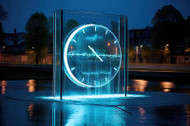A Brief History of the Light Emitting Diode (LED)
2nd Nov 2023
Often viewed as being at the forefront of modern energy efficient lighting, it may come as a surprise to learn that the LED has a history stretching right back to the early 1960s.
In October 1962, a scientist working for the General Electric Company, Nick Holonyak Jr demonstrated the first Light Emitting Diode (LED) capable of producing visible light. Prior to this, LED light bulbs could only emit invisible infra-red light similar to those used in modern TV remote controls. The new development which used a mixture of gallium arsenide and gallium phosphide, was limited to producing a red light, but Holonyak knew that his invention would change the world of lighting forever; in the February 1963 issue of Reader’s Digest, Holonyak predicted that the LED would eventually replace incandescent bulbs.
Take a look at this presentation on the BBC’s website: LED at 50: An illuminating history by the light’s inventor.
Unlike earlier types of bulbs which relied upon incandescent light sources, LED light bulbs utilised a relatively new technology called the semi-conductor which had been developed for use in transistor. The semi-conductor allows for direct conversion from electrical energy to optical energy without any intermediate process, which explains why LED light bulbs are the most energy efficient form of lighting.
As a new technology, LED light bulbs were very expensive- In 1962, one diode would cost around $260, and this high cost limited their practical uses. Later in the decade, further developments led to mass production which allowed manufacturers to incorporate them into their products. Although the LED light bulbs were rather dim and not practical for use in direct sunlight, the technology proved to have major uses for alphanumeric displays such as those in early handheld calculators.
A former graduate student of Holonyak, M. George Craford, invented the first yellow LED and improved the brightness of red and red-orange LED light bulbs by a factor of ten in 1972. These improvements, combined with the ever decreasing cost led to the continuing rise in the use of LED light bulbs; first in expensive equipment such as laboratory and electronics test equipment, then later in appliances like TVs, radios, telephones, calculators, and even watches.
The rapid pace of development that occurred throughout the 1960’s and into the 70’s seemed to decrease in the following decades. It wasn’t until 1995 when the first high-brightness blue LED was demonstrated by Shuji Nakamura of Nichia Corporation, that the possibilities of LED lighting took on a new dimension as scientists once again scrambled to achieve the next progression – white light that could provide a suitable replacement to traditional incandescent bulbs.
High-powered white LED light bulbs continued to evolve through the nineties and up to the current day. The light produced by the latest LED light bulbs is virtually indistinguishable from their incandescent counterparts, but also have the benefits of being up to 90% more energy efficient and lasting for years longer.
Holonyak himself is surprised that it’s taken so long for LED light bulbs to reach this point, but with the growing awareness of climate change and rising energy prices, we can be certain that it won’t be long before they provide the most common form of lighting for commercial and domestic applications.

 UK's #1 Specialist LED Retailer
UK's #1 Specialist LED Retailer
 Free Delivery Orders Over £50
Free Delivery Orders Over £50
 28 Day Returns Quality Guarantee
28 Day Returns Quality Guarantee
